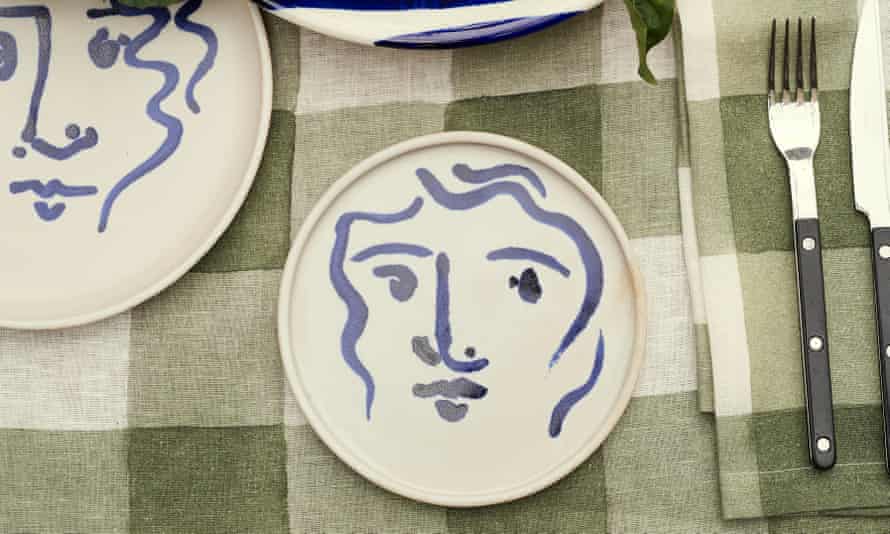Now interiors are the new black: fashion labels move into homeware design | Interiors
Hand-painted pottery, hand-woven chequered wool rugs and artisan basketware are officially the new must-haves following the launch of designer and TV presenter Laura Jackson’s new homewares hub, Glassette.
The London fashion designer, followed as much for her interiors advice and tablescapes as for her clothes and brand collaborations, launched the site last week to immediate acclaim from British Vogue.
Jackson founded the online shop to showcase small independent shops and makers around the world. “We want to make a change with homeware,” Jackson tells the Observer. “Glassette is all about thoughtful consumerism – not just the product, but giving a voice and a platform to the artisan who made it.”
Jackson isn’t the only high-profile fashion figure to turn her attention to homewares. Increasing numbers of fashion houses now also offer homewares, and designers who made their names on the catwalk are indulging their love of crafts. Matthew Williamson and Jonathan Saunders, two highlights of London Fashion Week in the 2000s and 2010s, have recently launched fully fledged interiors and furniture businesses respectively. Henry Holland parted ways with his eponymous fashion house in April 2020 to pursue a career in ceramics. It’s a move that has he says, reconnected him with his creativity.

“The fashion industry can be relentless and I think until you take a break you don’t realise how much burnout there is,” says Holland. “Working in ceramics is really fulfilling because you’re building something in solitude and don’t need a huge team. That has been really therapeutic.”
Holland estimates that the output in tableware from his Hackney studio, founded in April, is now 300 pieces a week, such is the demand. “This was supposed to be my quieter life, but that doesn’t seem to have happened,” he says. Fashion and homewares are similar, he adds. “You still have to find something interesting and unique to say, and create something covetable that fits into people’s lives.”
Retailers haven’t missed the opportunity to benefit from increasing appetites for homewares. Net-a-Porter’s Libby Page says the luxury fashion retailer’s homewares offering has increased by 3,000% in the past year since it decided to add almost 1,000 pieces by 37 brands.
“It’s more important than ever for designers to do something different to captivate an audience, and launching a category like home allows them to make some noise,” says Page, who points to the homeware arms of fashion houses such as Loewe – designed by the renowned JW Anderson – and Brunello Cucinelli as “super popular”.

Holland also notes that all his previous clothing retailers now have homewares departments. “The [fashion] industry is really struggling with a huge explosion of brands and a complete lack of brand loyalty so it’s tough to build a brand and sustain it. But homewares is a huge and growing market.”
The new appetite for interiors is a millennial-driven trend, according to Lucie Greene, founder of brand strategy practice Light Years.
“The oldest millennials are turning 40, becoming parents and buying houses and they’re shifting their connoisseurship around vintage fashion, beauty and new labels to upholstery providers and wallpapers,” she says. “Thanks to the 2008 global economic crisis, student debt and other structural changes, millennials in many ways have had to delay growing up. They’ve had babies later, bought properties later – if at all – and that in turn has made ‘growing up’ more aspirational.” Most millennials, she continues, “want nothing more than the spoils of middle age so it puts a chic curated home in the sweet spot”.
It is no surprise that social media has propelled the popularity of interiors. “Social media made people think about what they were wearing; now it’s making them think about where they live,” says Holland. “People are starting to curate their environments in the way they did with their wardrobes.”
Greene says it’s all to do with Instagram. “If TikTok has driven long-form consumption of comedic memes, creative videos and viral dances, Instagram has become the ultimate fishbowl for shoppable lifestyle porn,” says Greene, noting that general consumption of content “skyrocketed” throughout the pandemic.
“We are acutely aware of our home environments since we have had to work, live, socialise and relax in them all the time,” she says. “From gardens to home renovations and buying new ergonomic office furniture, increased exposure to our homes has made us want to invest more in them.”
This concept of purpose is what propelled Jackson to launch Glassette. “Purpose is an important word that means so much to everybody after Covid. It’s like, ‘What are we doing and why are we doing it and what does it mean?’,” she says. “That goes down to what are we buying as well as who are we buying it from. If it has a place in our home, it has to have purpose and meaning in our home, and I think that is something people resonate with after the past 18 months.”

